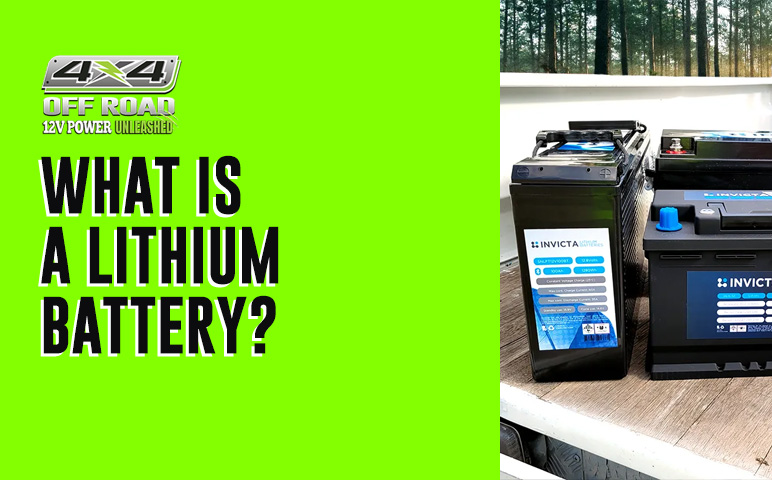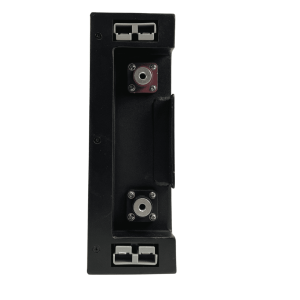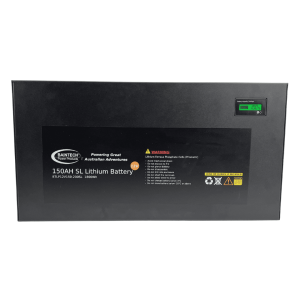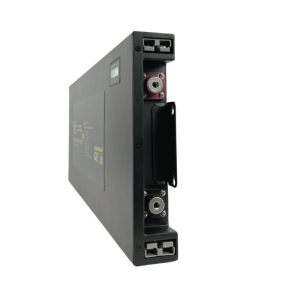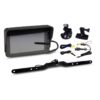In the dynamic world of battery technology, Lithium batteries have emerged as power-packed contenders, especially in the realm of dual battery setups. Understanding what Lithium batteries are, their benefits, pros, and cons, sheds light on why they have become the preferred choice for enthusiasts seeking reliable power solutions.
Table of Contents
What is a Lithium Battery?
A Lithium battery is a type of rechargeable battery that employs lithium-ion technology to store and release electrical energy. Unlike traditional lead-acid batteries, which use a liquid electrolyte, Lithium batteries utilize a solid-state electrolyte, typically made of lithium salts.
This unique composition allows Lithium batteries to deliver enhanced energy density, performance, and efficiency.
Key Components:
- Anode (Positive Electrode): The anode in a Lithium battery is typically composed of lithium cobalt oxide (LiCoO2), lithium manganese oxide (LiMn2O4), or lithium iron phosphate (LiFePO4). Each variant offers distinct characteristics, such as high energy density or enhanced safety.
- Cathode (Negative Electrode): The cathode in Lithium batteries is commonly made of graphite, and it is the site where lithium ions are stored during the battery’s charging and discharging cycles.
- Electrolyte: Unlike traditional batteries with liquid electrolytes, Lithium batteries use a solid-state electrolyte made of lithium salts. This solid electrolyte facilitates the movement of lithium ions between the anode and cathode, enabling the battery to charge and discharge efficiently.
- Separator: A separator keeps the anode and cathode physically separated within the battery to prevent short circuits while allowing the flow of lithium ions.
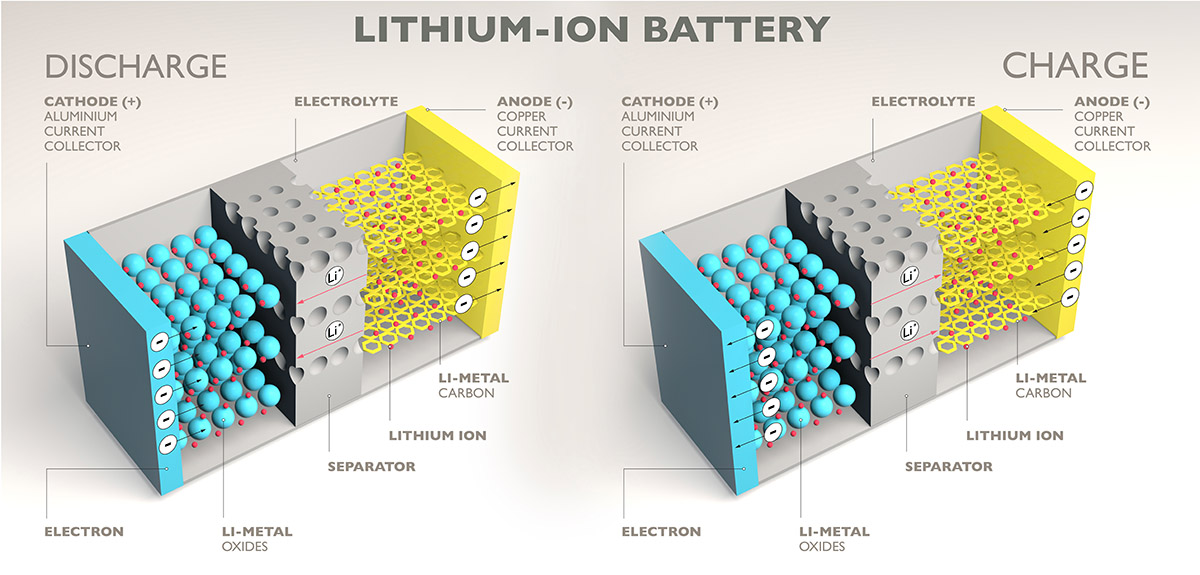
Working Principle:
During the charging process, lithium ions move from the cathode to the anode through the electrolyte and separator. When discharging, the lithium ions flow back from the anode to the cathode, generating electrical energy.
The solid-state electrolyte contributes to the overall stability of the battery and reduces the risk of leaks or spills.
Types of Lithium Batteries:
- Lithium Cobalt Oxide (LiCoO2): Commonly used in consumer electronics, these batteries offer high energy density but are sensitive to overcharging and can pose safety risks if not handled properly.
- Lithium Manganese Oxide (LiMn2O4): Known for enhanced safety and stability, these batteries find applications in power tools and medical devices.
- Lithium Iron Phosphate (LiFePO4): Notable for their long cycle life, high thermal stability, and improved safety, LiFePO4 batteries are popular in electric vehicles, solar energy storage, and other high-demand applications.
Applications:
Lithium batteries have become ubiquitous in various applications, including:
- Consumer Electronics: Lithium batteries power smartphones, laptops, cameras, and other portable devices due to their high energy density and lightweight design.
- Electric Vehicles (EVs): The automotive industry has increasingly adopted Lithium batteries for electric and hybrid vehicles, providing a balance between energy density and weight.
- Renewable Energy Storage: Lithium batteries play a crucial role in storing energy generated from renewable sources, such as solar and wind power, for later use.
- Dual Battery Setups: In the automotive and off-grid communities, Lithium batteries have gained popularity for dual battery systems, providing reliable and efficient power for accessories, camping gear, and other high-demand applications.
Pros of Lithium Batteries:
Lithium batteries shine with high energy density, extended lifespan, and quick charging, making them a top choice for efficient and powerful energy storage. Discover some pros to lithium batteries below.
1. High Energy Density: Lithium batteries boast an impressive energy density, providing more power in a smaller and lighter package compared to traditional batteries. This characteristic is particularly advantageous for applications with space constraints, such as dual battery setups in vehicles.
2. Longer Lifespan: One of the standout features of Lithium batteries is their extended lifespan. Lithium-ion technology enables a greater number of charge-discharge cycles, translating to a prolonged operational life. This longevity is a significant factor for those relying on dual battery systems for off-grid adventures or demanding applications.
3. Rapid Charging: Lithium batteries exhibit faster charging capabilities compared to their lead-acid counterparts. This rapid charging feature enhances the convenience and efficiency of dual battery setups, allowing users to replenish power quickly during stops or downtime.
4. Lightweight and Compact: The inherent design of Lithium batteries contributes to their lightweight and compact form. This is a crucial advantage for dual battery setups in vehicles where space and weight considerations are paramount. The reduced weight also contributes to improved fuel efficiency.
5. High Voltage Output: Lithium batteries maintain a consistent high voltage output throughout their discharge cycle. This is particularly beneficial for devices and systems that require a steady power supply, ensuring optimal performance.
6. Low Self-Discharge Rate: Lithium batteries have a low self-discharge rate, retaining their charge over extended periods. This characteristic is advantageous for dual battery setups, especially in vehicles that may have infrequent usage.
7. Maintenance-Free: Unlike traditional lead-acid batteries that may require periodic maintenance, Lithium batteries are virtually maintenance-free. This simplifies the upkeep of dual battery systems, reducing the hassle for users.
Cons of Lithium Batteries:
Despite their strengths, Lithium batteries have drawbacks. Check out the cons of owning a lithium battery.
1. Higher Initial Cost: One of the primary drawbacks of Lithium batteries is their higher upfront cost compared to traditional lead-acid batteries. However, many users consider this a worthwhile investment given the long-term benefits and performance advantages.
2. Sensitivity to Overcharging: Lithium batteries can be sensitive to overcharging, which may lead to safety concerns. Using a compatible charging system with built-in protection mechanisms is crucial to mitigate this risk.
3. Limited Temperature Range: Lithium batteries may experience performance issues in extreme temperatures. They may not operate optimally in very high or low temperatures, affecting both their efficiency and overall lifespan.
4. Safety Concerns: In certain conditions, Lithium batteries can pose safety concerns, especially if damaged or improperly handled. Thermal runaway, a rare but severe occurrence, can result in a fire or explosion. Manufacturers implement safety features, but proper usage and handling are crucial to mitigate risks.
5. Charging Compatibility: Not all charging systems are compatible with Lithium batteries. Using the wrong charger can lead to issues like undercharging or overcharging, affecting the battery’s performance and lifespan.
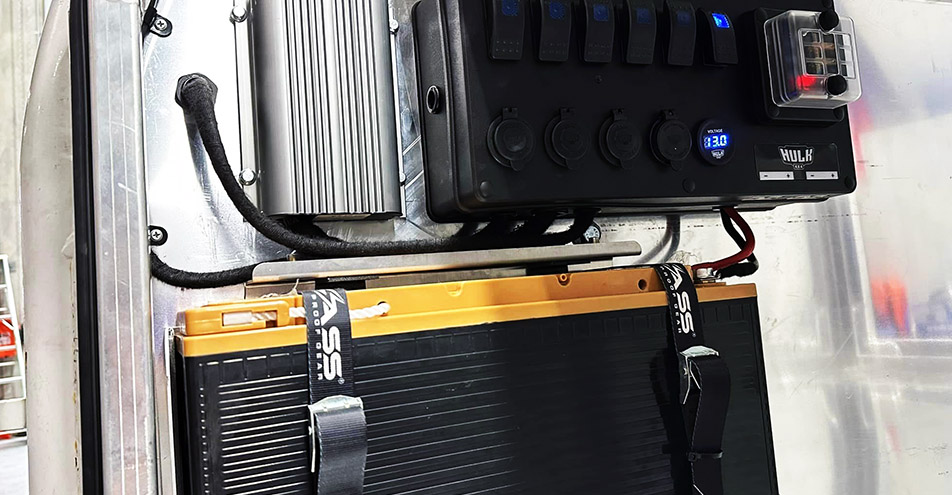
Why Lithium Batteries for Dual Battery Setups?
Efficiency in Powering High-Demand Accessories: Dual battery setups are often employed in vehicles equipped with power-hungry accessories like refrigerators, winches, or camping gear. Lithium batteries, with their high energy density and rapid charging capabilities, are well-suited to meet the demands of such accessories efficiently.
Lightweight for Off-Road Adventures: Off-road enthusiasts value the lightweight nature of Lithium batteries, contributing to improved off-road performance and handling. The reduced weight is particularly beneficial when navigating challenging terrains.
Extended Off-Grid Capability: For those venturing off the grid, Lithium batteries offer a reliable power source with an extended lifespan and low self-discharge rate. This ensures a consistent power supply for extended periods, supporting prolonged off-grid adventures.
Conclusion:
Lithium batteries have revolutionized the landscape of energy storage, and their application in dual battery setups brings a new level of efficiency, reliability, and convenience. Despite the initial investment, the long-term benefits, including extended lifespan, rapid charging, and lightweight design, make Lithium batteries a compelling choice for enthusiasts seeking optimal performance in their vehicles and off-grid experiences.
As technology continues to advance, Lithium batteries are expected to play an increasingly pivotal role in powering the future of dual battery systems.


